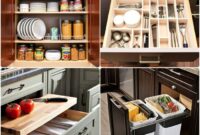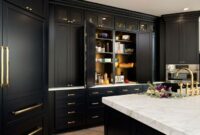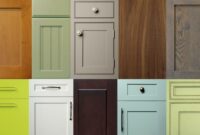Cabinet hardware options are surprisingly diverse, transforming a simple cabinet into a statement piece. From sleek modern pulls to ornate traditional knobs, the choices are vast and can dramatically impact the overall aesthetic of your kitchen or bathroom. This guide explores the myriad of styles, materials, and installation techniques to help you find the perfect hardware to complement your design vision.
We’ll cover everything from the different types of hardware available – knobs, pulls, handles, and hinges – to the various materials like brass, stainless steel, and ceramic, and their respective durability and maintenance requirements. We’ll also delve into the impact of finishes (brushed nickel, oil-rubbed bronze, etc.) and styles (minimalist, ornate, transitional) on the overall look and feel of your space.
Finally, we’ll provide practical advice on sizing, placement, and installation techniques to ensure a seamless and professional finish.
Types of Cabinet Hardware
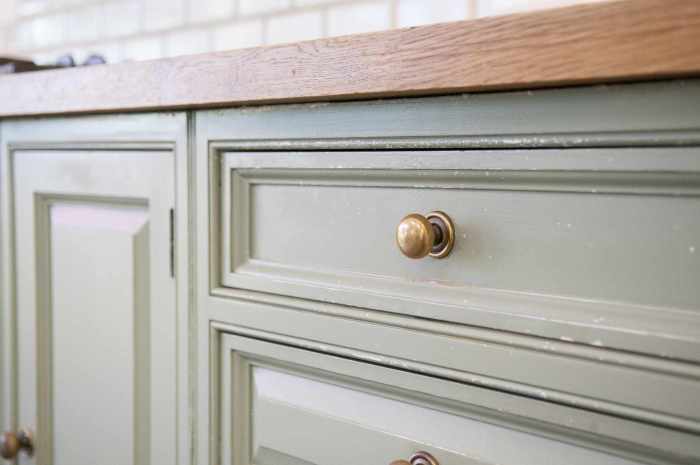
Source: thespruce.com
Choosing the right cabinet hardware can dramatically impact the overall look and feel of your kitchen or bathroom. The seemingly small details of knobs, pulls, and hinges contribute significantly to the style and functionality of your cabinetry. This section will explore the various types of cabinet hardware available, the materials they’re made from, and how to select appropriate hardware for different design styles.
Cabinet Hardware Types and Materials
The selection of cabinet hardware is vast, offering a wide array of choices to suit any design preference and budget. The table below categorizes common hardware types by material and typical application.
| Type | Material | Style | Common Uses |
|---|---|---|---|
| Knobs | Brass, Stainless Steel, Ceramic, Wood, Glass | Traditional, Modern, Rustic | Kitchen cabinets, bathroom vanities, drawers |
| Pulls (Cup Pulls, Bar Pulls, Apron Pulls) | Brass, Stainless Steel, Zinc Alloy, Wood | Traditional, Modern, Rustic, Transitional | Kitchen cabinets, bathroom vanities, drawers, dressers |
| Handles (D-Handles, Arch Handles, T-Handles) | Brass, Stainless Steel, Zinc Alloy | Modern, Contemporary, Transitional | Kitchen cabinets, bathroom vanities, drawers |
| Hinges | Stainless Steel, Brass, Nickel | Various, often chosen for functionality over style | Cabinet doors, drawers (concealed hinges are common) |
Cabinet Hardware Material Properties
The durability and maintenance requirements of cabinet hardware vary significantly depending on the material used.
Brass: Brass is a durable metal alloy known for its rich, warm tone. It can develop a patina over time, adding character. Regular polishing with a brass cleaner maintains its shine. However, it can tarnish if not properly cared for.
Stainless Steel: Stainless steel is highly durable and resistant to corrosion and rust. It requires minimal maintenance, usually just a wipe down with a damp cloth. Its sleek, modern look is very popular.
Ceramic: Ceramic knobs and pulls offer a unique aesthetic, often featuring intricate designs and vibrant colors. They are generally less durable than metal options and can chip or crack if dropped. Gentle cleaning with a soft cloth is recommended.
Wood: Wooden knobs and pulls add a touch of warmth and natural beauty. The durability varies depending on the wood type and finish. Regular dusting and occasional polishing with a wood conditioner will help maintain their appearance. Wood is susceptible to moisture damage, so it’s less suitable for high-humidity areas.
Choosing the right cabinet hardware can dramatically impact the overall look of your project. For instance, the hardware you select for a custom wine cellar can greatly enhance its style. If you’re considering building a truly unique space, check out the stunning options available for Custom Wine Cellar Cabinets to see how hardware choices play a role in the overall design.
Ultimately, the perfect hardware complements your cabinetry and creates a cohesive, stylish finish.
Cabinet Hardware Selection for Different Styles
The choice of cabinet hardware is crucial in defining the overall style of a space. Below are examples of hardware choices for three distinct cabinet styles:
Modern: A modern kitchen might feature sleek, minimalist cabinetry with simple, straight lines. Appropriate hardware choices would include stainless steel bar pulls or cup pulls, or perhaps brushed nickel D-handles. The emphasis is on clean lines and a lack of ornamentation. A picture might show flat-panel cabinets with long, thin stainless steel bar pulls.
Traditional: Traditional kitchens often feature ornate details and a sense of history. Brass knobs and pulls, possibly with intricate detailing, are a classic choice. These could be paired with decorative hinges to enhance the overall aesthetic. An example would be a shaker-style cabinet with ornate brass knobs and cup pulls.
Rustic: Rustic kitchens embrace natural materials and a sense of warmth. Wooden knobs, possibly with a distressed finish, or black iron pulls would complement the style. The hardware should enhance the natural, unrefined look of the cabinetry. Imagine a cabinet made from reclaimed wood with large, black iron pulls.
Hardware Finishes and Styles
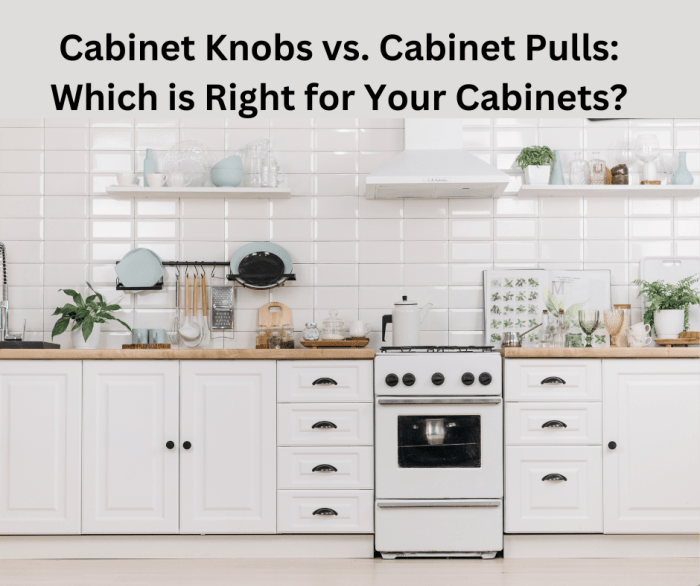
Source: com.au
Choosing the right cabinet hardware is crucial for achieving your desired aesthetic. The finish and style of your knobs and pulls significantly impact the overall look and feel of your kitchen or bathroom, complementing or contrasting with your cabinetry and other design elements. Careful consideration of these factors ensures a cohesive and visually appealing space.
Choosing the right cabinet hardware can really elevate the look of your furniture. The options are endless, from sleek modern pulls to ornate traditional knobs. This is especially true when considering something as statement-making as High-End Entertainment Center Cabinets , where the hardware can dramatically impact the overall aesthetic. Ultimately, the perfect hardware will depend on your personal style and the overall design of the piece.
The finish and style of your cabinet hardware work together to create the overall aesthetic. Different finishes offer varying levels of sheen and color, while different styles range from sleek and modern to ornate and traditional. The interplay between these two aspects is key to achieving a harmonious design.
Choosing the right cabinet hardware can really elevate your closet’s look. From sleek modern pulls to ornate knobs, the options are endless! If you’re starting from scratch, consider the possibilities offered by Custom Closet Cabinets , where you can perfectly match your hardware to your overall design. This ensures your cabinet hardware complements your custom closet perfectly, creating a cohesive and stylish space.
Cabinet Hardware Finishes
The finish of your cabinet hardware significantly affects the overall look and feel of your space. Popular choices offer a wide range of visual impact and practical considerations. Here’s a closer look at some common finishes and their respective advantages and disadvantages:
- Brushed Nickel: A slightly textured, muted silver finish.
- Pros: Versatile, hides fingerprints well, complements both modern and traditional styles.
- Cons: Can appear less shiny than polished chrome, may show scratches more easily than some other finishes.
- Oil-Rubbed Bronze: A dark, warm brown finish with a slightly aged appearance.
- Pros: Rich, sophisticated look, hides fingerprints effectively, works well with traditional and transitional styles.
- Cons: Can be more prone to tarnishing than other finishes, requires occasional cleaning to maintain its luster.
- Polished Chrome: A highly reflective, bright silver finish.
- Pros: Sleek, modern look, easy to clean, very durable.
- Cons: Shows fingerprints easily, can feel cold and impersonal in some settings.
- Matte Black: A flat, non-reflective black finish.
- Pros: Modern and sophisticated, hides fingerprints well, adds a touch of drama.
- Cons: Can show dust more easily than other finishes, may not be suitable for all styles.
Cabinet Hardware Styles
The style of your cabinet hardware is just as important as the finish. Different styles evoke distinct moods and aesthetics, profoundly influencing the overall design of your kitchen or bathroom.
Choosing the right cabinet hardware can really elevate your kitchen’s look. The options are endless, from sleek modern pulls to ornate knobs, and the style you choose should complement your overall design. If you’re considering maximizing space, check out these Multi-functional cabinets for clever storage solutions. Ultimately, the hardware you select will tie everything together, completing the look of your cabinets.
- Minimalist: Characterized by clean lines, simple shapes, and a lack of ornamentation. Imagine sleek, bar-style pulls or small, unadorned knobs in a brushed nickel or matte black finish. The overall effect is understated elegance and a sense of modern simplicity.
- Ornate: Features elaborate details, curves, and decorative elements. Think intricately carved knobs or pulls with decorative flourishes, often in finishes like oil-rubbed bronze or polished brass. This style creates a feeling of richness and opulence, best suited for traditional or Victorian-style spaces.
- Transitional: Blends elements of both traditional and modern styles. This might involve pulls with simple shapes but subtle decorative details, or knobs with a slightly more ornate design but in a contemporary finish like brushed nickel or matte black. The result is a balanced aesthetic that avoids being overly stark or overly fussy.
Hardware Finishes and Cabinet Materials
The interaction between cabinet hardware finishes and cabinet materials significantly impacts the final aesthetic. The right combination can elevate the overall design, while a poor choice can create a clash.
- Wood Cabinets: Warm wood tones often pair well with oil-rubbed bronze or brushed nickel hardware, creating a classic and inviting feel. Polished chrome can add a touch of modern contrast, while matte black provides a striking, contemporary look.
- Laminate Cabinets: The smooth surface of laminate cabinets complements both sleek, modern finishes like polished chrome or matte black, and more traditional finishes like brushed nickel. Oil-rubbed bronze can add warmth and depth to a laminate cabinet.
- Painted Cabinets: The color of the paint greatly influences the hardware choice. Light-colored cabinets often pair well with brighter finishes like polished chrome or brushed nickel, while darker cabinets can handle bolder choices like matte black or oil-rubbed bronze.
Cabinet Hardware Sizing and Placement: Cabinet Hardware Options
Choosing the right size and placement for your cabinet hardware is crucial for both functionality and aesthetics. Properly sized and positioned knobs and pulls make opening and closing cabinets a breeze, while aesthetically pleasing placement enhances the overall look of your kitchen or bathroom. Getting this right can elevate your entire design.
Standard cabinet hardware sizes vary depending on the type of cabinet and personal preference. However, understanding typical dimensions and placement guidelines will help you achieve a balanced and functional design.
Standard Cabinet Hardware Dimensions
The following table provides typical dimensions for cabinet knobs and pulls. Remember that these are guidelines, and actual dimensions can vary depending on the manufacturer and style.
| Cabinet Type | Knob Diameter (inches) | Pull Length (inches) |
|---|---|---|
| Base Cabinets | 1 – 1.5 | 3 – 12 |
| Upper Cabinets | 1 – 1.25 | 3 – 8 |
| Drawers | 1 – 1.5 | 3 – 6 |
Note: These are average ranges. Larger, more substantial pulls might be used for larger base cabinets, while smaller knobs might be preferable for delicate upper cabinets. Always check the manufacturer’s specifications for precise dimensions.
Optimal Hardware Placement for Functionality and Aesthetics
Proper placement ensures easy access and a visually appealing result. Consider these guidelines:
- Centering: Knobs should be centered both horizontally and vertically on the cabinet door or drawer face. Pulls should be centered horizontally, with the center of the pull aligned with the center of the door or drawer.
- Spacing: Maintain consistent spacing between hardware on multiple doors or drawers within a cabinet grouping. This creates a uniform and polished look.
- Accessibility: Place hardware at a comfortable height and reach. For base cabinets, handles should be placed at a height easily accessible to users of all sizes. Upper cabinets should be placed at a reachable height, considering the average user’s arm length.
- Alignment: Ensure all hardware is perfectly aligned, both horizontally and vertically, across all cabinets and drawers for a professional and consistent finish. Slight misalignments can be very noticeable.
Measuring Cabinet Doors and Drawers for Accurate Hardware Placement
Accurate measurements are essential for proper hardware installation. Follow these steps:
- Measure the Door or Drawer Face: Use a measuring tape to determine the exact width and height of the cabinet door or drawer face. Note these measurements.
- Determine Hardware Center Point: Divide the width of the door or drawer face by two to find the center point. This will be the location for the center of your knob or the center of your pull.
- Mark the Center Point: Use a pencil to lightly mark the center point on the door or drawer face. This serves as a guide for hardware installation.
- Consider Overlap: For pulls, measure the length of the pull and ensure that it doesn’t extend beyond the edges of the door or drawer. Some overlap might be acceptable depending on the style of the pull and the cabinet design.
- Double-Check: Before drilling any holes, double-check your measurements to avoid mistakes. A slight miscalculation can lead to off-center hardware.
By following these steps, you can ensure that your cabinet hardware is correctly sized and placed for both functionality and aesthetic appeal.
Installation Methods and Techniques
Installing cabinet hardware might seem daunting, but with the right tools and techniques, it’s a manageable DIY project. This section details the process for various hardware types, compares installation methods, and provides a step-by-step guide for installing European-style hinges. Proper installation ensures both functionality and a professional-looking finish.
Different cabinet hardware requires different installation methods. Some methods are simpler than others, and the choice often depends on the type of hardware and the material of your cabinets. Factors like cabinet thickness and the desired level of strength also influence the best approach.
Installing Different Types of Cabinet Hardware
The following Artikels the general process for installing common cabinet hardware. Remember to always pre-drill pilot holes to prevent wood splitting, especially when working with hardwoods.
- Knobs: Most knobs are installed with a single screw through the knob and into the cabinet door. Simply align the knob, insert the screw, and tighten. Some knobs may have a decorative backplate that requires separate screws.
- Pulls: Pulls typically require two screws, one on each end. Align the pull, insert the screws, and tighten. Again, pre-drilling pilot holes is crucial. Larger pulls may require longer screws to ensure a secure fit.
- Hinges: Hinge installation varies greatly depending on the type (e.g., overlay, inset, European). Generally, hinges involve screwing the hinge cup to the cabinet door and the hinge leaf to the cabinet frame. Precise placement is critical for proper door alignment.
- Drawer Slides: Drawer slide installation can be more complex. It usually involves attaching the slide’s mounting brackets to both the drawer and the cabinet sides. Precise alignment is crucial for smooth drawer operation. Some slides require specific tools for adjustment.
Comparing Installation Methods
Several methods exist for attaching cabinet hardware, each with its pros and cons.
- Screwing: This is the most common method, offering excellent strength and durability. It requires a screwdriver and potentially a drill for pre-drilling pilot holes. Illustration: A picture showing a person using a screwdriver to install a knob, with a pre-drilled pilot hole visible. The screwdriver is shown accurately with its components and the pilot hole is shown to prevent splitting.
- Gluing: Glue is sometimes used in conjunction with screws, especially for lighter hardware or when screwing isn’t feasible. However, glue alone is rarely sufficient for hardware that experiences significant stress. Illustration: A picture showing a small decorative knob being glued and then screwed into place, emphasizing the use of both glue and screws for added strength.
- Specialized Tools: Certain hardware, like European-style hinges, may require specialized tools for precise installation and adjustment. These tools often simplify the process and ensure accurate placement. Illustration: A picture showcasing a jig used for accurate placement of European-style hinges, showing the tool and how it ensures consistent placement of hinges on cabinet doors.
Installing European-Style Hinges
European-style hinges are known for their sleek design and adjustability. Their installation, while requiring precision, is relatively straightforward.
Choosing the right cabinet hardware can dramatically impact a kitchen’s look and feel. For smaller spaces, careful consideration is key, and often involves opting for sleek, minimalist designs. If you’re dealing with limited space, check out these Space-saving cabinets to maximize storage. Ultimately, your hardware choices should complement the overall design and functionality of your cabinets, whether large or small.
- Locate Hinge Placement: Use a template (often provided with the hinges) to mark the hinge cup location on the cabinet door and the hinge leaf location on the cabinet frame. Accurate placement is critical for proper door alignment.
- Pre-drill Pilot Holes: Pre-drill pilot holes at the marked locations to prevent wood splitting. Use a drill bit slightly smaller than the hinge screws.
- Attach Hinge Cups: Carefully align the hinge cups with the marked locations and attach them to the cabinet door using the provided screws. Ensure they are flush with the door surface.
- Attach Hinge Leaves: Similarly, attach the hinge leaves to the cabinet frame using the provided screws, ensuring they are aligned with the hinge cups.
- Adjust Hinges: Once installed, adjust the hinges to ensure the door aligns perfectly with the cabinet frame. Most European hinges allow for three-way adjustment (depth, height, and side-to-side).
Cabinet Hardware Trends and Considerations
Choosing the right cabinet hardware can significantly impact the overall look and feel of your kitchen or bathroom. Current trends reflect a move towards both minimalist designs and a renewed appreciation for handcrafted details, offering a wide range of styles to suit diverse tastes and budgets. Understanding these trends and the factors influencing your selection will help you make informed decisions that enhance your space for years to come.Current trends in cabinet hardware showcase a blend of modern minimalism and timeless elegance.
Materials and finishes play a crucial role in achieving the desired aesthetic.
Popular Cabinet Hardware Styles, Materials, and Finishes
Modern minimalist designs often feature sleek, linear pulls in brushed nickel or matte black finishes. These understated pieces complement contemporary kitchens and bathrooms, providing a clean and uncluttered look. Think of long, thin bar pulls or minimalist cup pulls in a subtle metallic finish. In contrast, a growing trend embraces warmer tones and more traditional styles. Knobs and pulls in antique brass, oil-rubbed bronze, or even aged pewter offer a sense of richness and history, perfectly suited to transitional or traditional design schemes.
Consider ornate knobs with detailed carvings or substantial apron pulls for a more luxurious feel. Natural materials like wood or ceramic are also gaining popularity, adding a touch of organic texture and warmth to the space. Imagine a set of wooden knobs with a slightly distressed finish, or ceramic pulls with unique glazing techniques.
Factors to Consider When Selecting Cabinet Hardware, Cabinet hardware options
Budget is a primary consideration. Hardware prices can vary dramatically depending on the material, style, and brand. Setting a realistic budget beforehand helps narrow down the options and prevents overspending. Style preference plays a crucial role. The hardware should complement the overall design of the kitchen or bathroom, whether it’s modern, traditional, transitional, or eclectic.
Consider the existing color palette, countertop materials, and other fixtures to ensure a cohesive look. The overall design of the kitchen or bathroom dictates the scale and style of the hardware. Larger kitchens might accommodate larger, more statement-making pieces, while smaller spaces might benefit from more subtle and compact hardware. Functionality is also key. Choose hardware that is comfortable to use and durable enough to withstand daily wear and tear.
Think about the size and shape of the pulls and knobs in relation to the size of the cabinet doors and drawers.
Resources for Cabinet Hardware Selection and Installation
Finding reliable information on cabinet hardware is relatively straightforward. Home improvement magazines often feature articles and guides on kitchen and bathroom design, frequently including sections on hardware selection. Many home improvement stores and showrooms provide detailed catalogs and brochures showcasing their hardware lines. Furthermore, design professionals such as interior designers and kitchen specialists possess extensive knowledge and experience in this area, offering valuable advice and recommendations.
Finally, online forums and communities dedicated to home improvement often provide user reviews and insights on specific products and installation techniques.
Closing Summary
Choosing the right cabinet hardware is more than just selecting functional pieces; it’s about enhancing the style and personality of your home. By carefully considering factors like material, finish, style, and size, you can create a cohesive and visually appealing design. Remember to prioritize functionality alongside aesthetics, ensuring your chosen hardware is both beautiful and easy to use. With the information provided in this guide, you’re well-equipped to embark on your cabinet hardware journey with confidence and creativity.
FAQ Resource
What’s the difference between knobs and pulls?
Knobs are round and attached to the cabinet door with a single screw, requiring one hand to open. Pulls are longer and have two mounting points, allowing for a better grip and often easier opening.
How do I clean different cabinet hardware finishes?
Cleaning methods vary by material. Generally, a soft cloth and mild soap and water suffice. Avoid abrasive cleaners. Refer to the manufacturer’s instructions for specific cleaning recommendations.
How often should I replace my cabinet hardware?
This depends on usage and material. With proper care, high-quality hardware can last for many years. However, if hardware shows significant wear or damage, replacement is advisable for both aesthetics and functionality.
Can I install cabinet hardware myself?
Yes, many types of cabinet hardware are relatively easy to install with basic tools. However, for complex installations or if you’re unsure, professional help is recommended.

